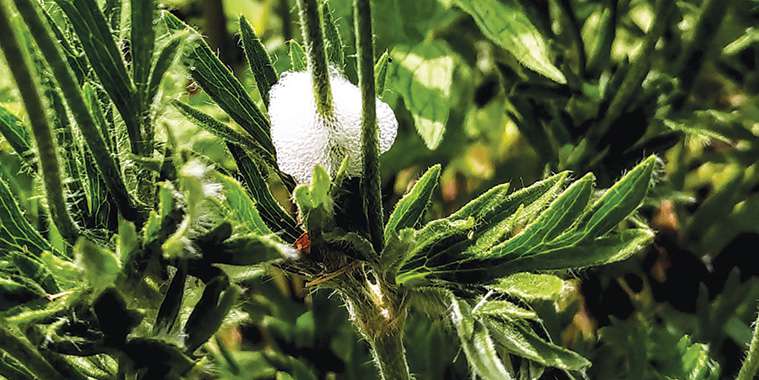This is the season for all the creepy crawlies to visit your favourite plants and sometimes they appear in mysterious garb. Many of them are looking for pollen or the sweet nectars that plants produce, but others have a secondary quest.
Take the spittlebug, Cercopoidea, for instance. This interesting creature, when he is in the larval stage, hides under a mantle of foam he excretes using your plant’s sap to cover himself and keep him from harm by predators. Since he has no hard shell, the foam also keeps him from drying out and saves his tender exterior from sunburn or frost. These bundles of “spit” are commonly called frog spit or even snake spit.
A sucking insect, distantly related to aphids, the spittlebug has the perverse habit of taking his sustenance from the xylem of a plant, which draws water and some nutrients from the soil to help feed the manufactory in the leaves. (Most insects feed on the more sugary leaves). You will see Mr. Spittlebug on the stems of your plants, surrounded by foam.
Now at this stage, he’s just a kid — it is only the little wingless green nymph that manufactures the acrid tasting spittle. When he grows up, he will emerge as black, brown or tan, about an eighth to a quarter inch long. At this point, he often gets a new name: froghopper. This is for his face which supposedly resembles that of a frog and for his amazing ability to jump. He can take a vertical leap of two feet — 100 times his length.
Spittlebugs show a preference for nitrogen-fixing plants such as legumes (peas, lupins, that sort of thing) and it is postulated that they are most plentiful on plants grown in healthy soil, but that may just be the conceit of observers. They also seem to enjoy the sap of spruce and junipers.
The good news is that they do very little damage in the home garden. Knock them off with the garden hose or wipe them off with your gloved fingers as they can carry viruses, such as mosaic virus, that do damage plants and can kill them.
What you always wanted to know about pollen
You may have notice the tremendous load of pollen produced by flowering plants this spring. It has been followed by huge seed burden, which may indicate a tough winter coming up. But more about that another time.
Pollen is a wonderful, protein-rich particle, much prized by queen bees, but especially important to plant fertilization because it carries the male sperm of plants.
When a compatible pollen grain lands on the stigma of a flower — dropped there by a bee or blown by the wind — it sticks — foreign pollen falls off. And then the magic begins. Stimulated by a molecule that also plays a role in our own nervous system, the grain of pollen begins to grow a long slender tube that reaches down the style of the stigma to find the ovules in the ovary below.
Here it delivers the generative cell that will combine with the ovule and begin the process of developing a new plant. This molecule has only recently been discovered and is thought to have possible values to human spinal cord regeneration.
Not all plants reproduce this way, of course, but most of the flowering ones do.
Pollen is also prized by bees. A full colony of bees can collect 50,000 loads of pollen a day.
The bees pack the powder into granules, adding honey or nectar from honey sacs where it is then transported back to the hive.
Finally, an enzyme is added to prevent germination, metabolizing the pollen for food, thus preserving the bee pollen benefit nutritionally.
Dorothy Dobbie is the publisher of the Manitoba Gardener and has a weekly radio show on Nostalgia Radio CJNU 97.3 FM. Tune in Sundays at 8:00 A.M. or listen online.



